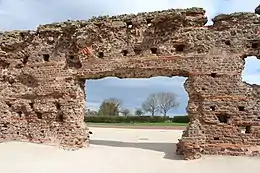Wroxeter Stone
The Wroxeter Stone is the name given to a c. 460–75 AD inscribed stone unearthed in 1967 at Wroxeter, England (earlier the Roman city of Viroconium Cornoviorum).[1] The stone is in the care of English Heritage, and was included in A History of Ireland in 100 Objects as the Cunorix Stone.[2]

Inscription
Its inscription is in an Insular Celtic language, identified by the Inscribed Stones Project at UCL as "partly-Latinized Primitive Irish",[3] and comes from a period several decades after the collapse of Roman authority in Roman Britain, when Irish raiders had begun to make permanent settlements in South Wales and south-western Britain.[2] The text reads:[1] CVNORIX | MACVSM/A | QVICO[L]I[N]E, traditionally normalised as Cunorix macus Maqui Coline and translated as Cunorīx son of Maqqos Colinī, where Cunorīx and Maqqos Colinī are personal names.[1][3] Cunorīx, literally meaning 'hound-king', is a well attested Celtic name,[1] and may relate to the etymology of the name of Cynric of Wessex, a 6th-century king.[4][5] Maqui Coline was read by Kenneth H. Jackson as a rendering of Primitive Irish *Maqqī-Colinī (genitive of *Maqqos-Colinī); this name literally means 'son of holly', but is an example of a type of name fashionable in early Irish that, despite looking like patronyms, were in fact given names. It is one of a number of such names that include words for trees and is attested in later Old Irish in the form Macc-Cuilinn.[1]
References
- Wright, R.P. and Jackson, K.H. (1968) `A Late Inscription from Wroxeter', The Antiquaries Journal, 48, part 2, pp. 296-300 doi:10.1017/S0003581500034934
- "Cunorix Stone", A History of Ireland in 100 Objects
- CISP database, WRXTR/1, recovered 14 Sep 2014
- Patrick Sims-Williams, 'The Settlement of England in Bede and the Chronicle', Anglo-Saxon England, 12 (1983), 1–41, doi:10.1017/s0263675100003331 (p. 30 n. 131).
- Keith J Matthews, 'What's in a Name? Britons, Angles, Ethnicity and Material Culture from the Fourth to Seventh Centuries', The Heroic Age, 4 (2001).